Viewing: Blog Posts Tagged with: Scientist, Most Recent at Top [Help]
Results 1 - 6 of 6
Blog: drawboy's cigar box (Login to Add to MyJacketFlap)
JacketFlap tags: lab, spies, Patrick Girouard, children, illustration, robots, Drawboy, illustration friday, art, scientist, Add a tag
Blog: Writing and Illustrating (Login to Add to MyJacketFlap)
JacketFlap tags: Montery Bay Aquarium, Artist, Interview, inspiration, Process, scientist, authors and illustrators, Kirsten Carlson, Illustrator Saturday, Illustrator's Saturday, Add a tag
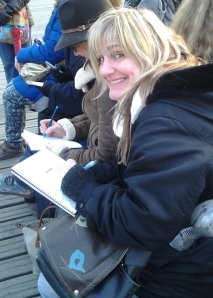 Kirsten’s career combines what she loves best about science, art & design. She is dedicated to creating illustrations, graphics, logos and stories that inspire connections between people & nature.
Kirsten’s career combines what she loves best about science, art & design. She is dedicated to creating illustrations, graphics, logos and stories that inspire connections between people & nature.
After volunteering and working for over 10 years with Monterey Bay Aquarium, Kirsten now works out of her own studio. She is a children’s book illustrator & writer, as well as a visual science communications consultant. Kirsten collaborates on projects with scientists, educators, educational institutions, private companies and publishers to tell people stories about nature and science.
Kirsten illustrations style ranges from whimsical watercolor paintings to scientifically accurate pen & ink illustrations. The project’s audience dictates the style and medium. Her illustration work appears in scientific journals, greeting cards, posters, books, aquariums and brochures. Her design communication projects include logos, print and online collateral.
Kirsten brings her enthusiasm and skills as artist, scientist, and designer to every project she works on. She finds inspiration in nature and knowledge and strives to communicate that in her work.
Kirsten is the SCBWI Regional Advisor in Germany+Austria. She started out on AdCom in WA for 2 years (designing newsletter and conferece materials and the traveling booth use at different events in the USA like ALA). After she moved to Germany, she took over as Illustrator Coordinator for 1.5 yrs before taking over the RA position there. She just became an SCBWI board member and the International Illustrator Coordinator last fall, but has to retire when her family moves to hawaii (IIC must live on international soil).
She and her husband Dave, along with their two cats and two dogs, currently live near the Black Forest in Southern Germany.
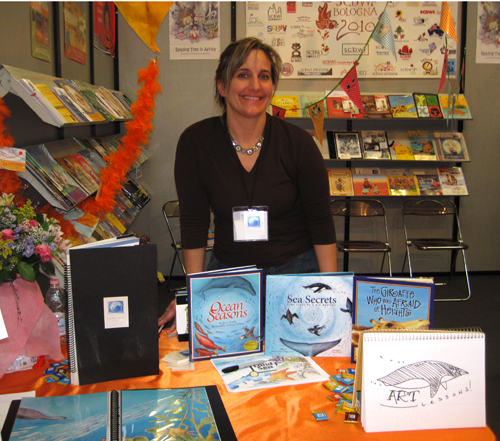
Here is Kirsten:
I worked directly with the author, Joni Sensel, to create the design for the cover. Because it was going to be the 3rd in a series we wanted to incorporate some elements so it echoed the previous covers, I knew I wouldn’t be able to copy the illustration style of the previous covers so I suggested scratchboard because I know well from my scientific illustration work and I wanted to create in image with strong contrast.
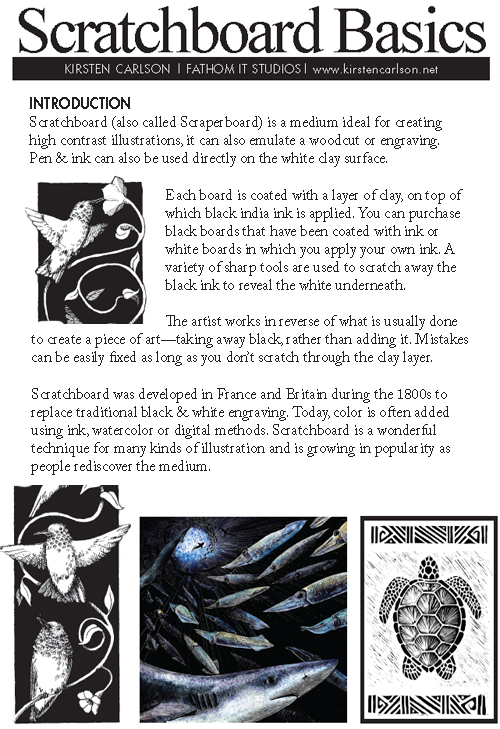
- clay-coated board
- scratching tool(s)
- permanent ink (ie. india ink)
- permanent ink pens (for adding lines)
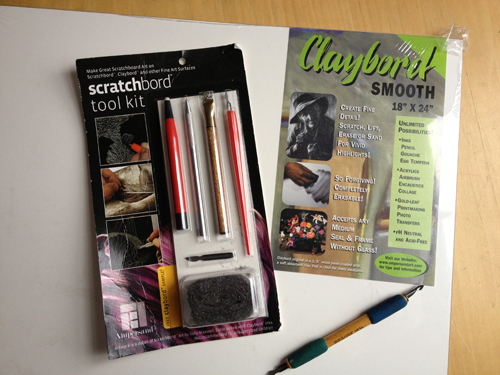

I did some very loose thumbnails and we quickly chose three compositions that I sketched in more detail. We ended up combining two of the sketches into one composition, and I did a preliminary sketch.
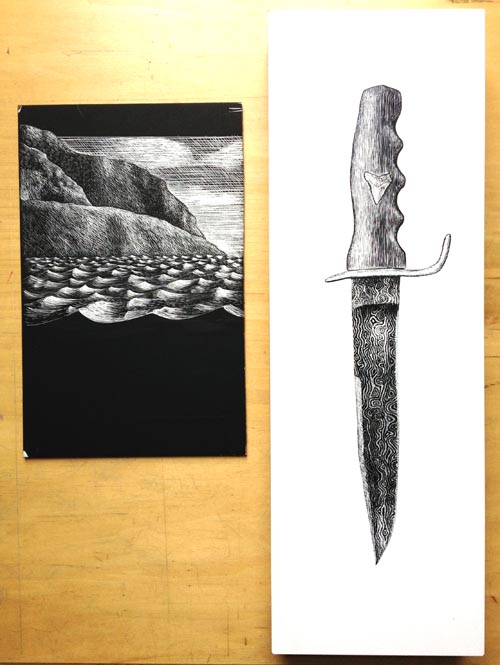
I kept the background, people and knife elements separately.

My assistant (aka husband) made a knife specifically for me based partly on Joni’s description of the knife in the story. Then all I had to do, was draw it from the real-thing.
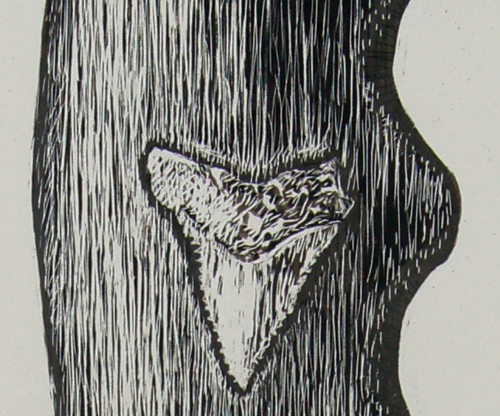
I uploaded a video showing the process but it didn’t turn out well (learning curve. newbie mistake stuff) but maybe it will help visualize the following. https://vimeo.com/67728895
steps:
1.transfer art to clay-coated board (usually using Saral graphite paper in blue)
2.ink the areas that will be ‘mostly’ black
3.wait for it to dry (blow dryer speeds up the process)
4.scratch and blow off the dust (it is better to use a brush to wipe the scraped powder into a pile, but I either blow or tap the art on the table)
5.the more you scratch the better it gets. I am a messy-scratcher, some ppl are very precise.
6.repairing problem spots is easy—scrape away excess ink or add ink with pens or brush.
7.two tips: make sure you let the ink dry completely before scraping, if the clay is damp from the ink you won’t get a nice clear line; it’s better to apply ink to thinly and have to do multiple layers than add it too thick and get a thick-spot on the illustration (if you buy pre-inked clay board you skip this problem)
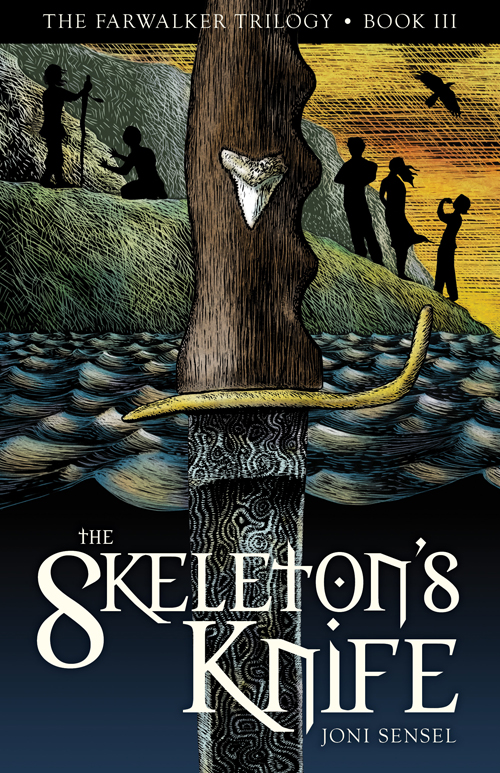
The final cover is a Black and white illustration in scratchboard with digital color, using the same font as the first book (and edition) in the series.
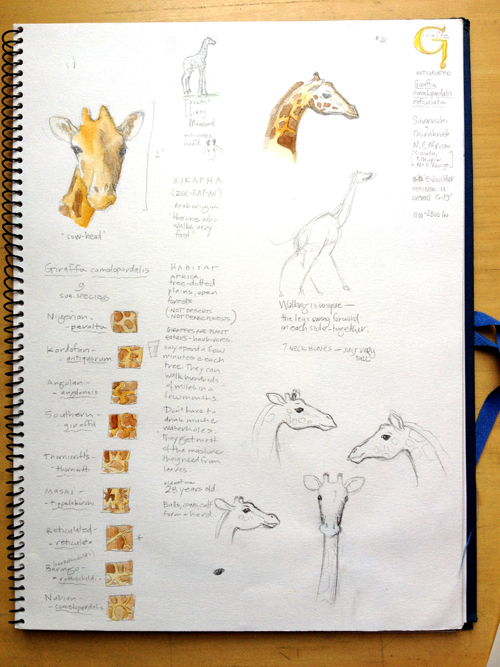
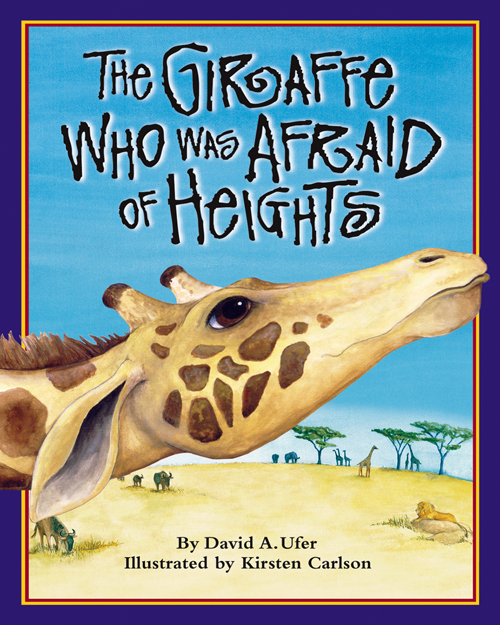
I used gouache to paint the cover and the publisher added the background from another spread to go behind the giraffe head) and added the text and border.
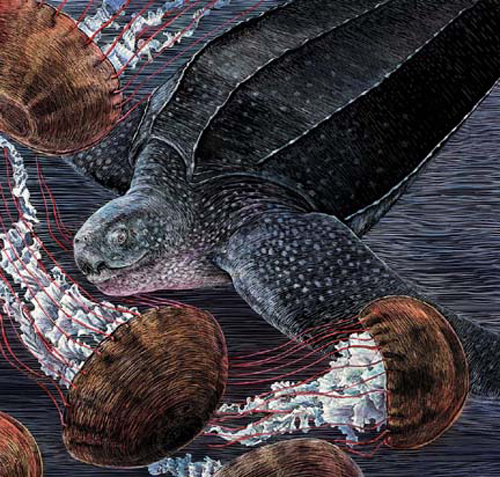
How did you end up moving to Germany. How long have you been there? Do you plan to go back to the states in the future?
I fell in love with a military man while living in Monterey, California. We arrived in Germany five years ago (Sept 08) for his job and were supposed to stay in Europe until 2015. However, the military made some unexpected changes and we are moving to Hawai’i this summer. I wasn’t ready to leave but I’m super excited about being near the ocean again.
I see that you have a BS in Biology.
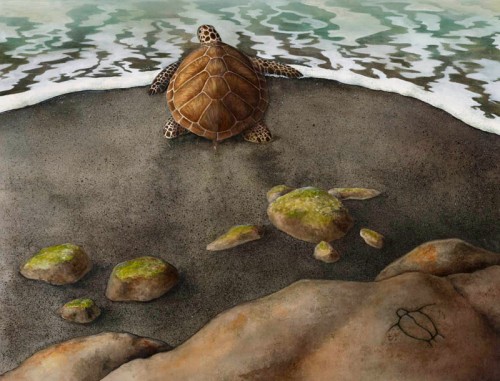
How and when did you get involved in art?
I’ve have been artistic since childhood, but I didn’t start pursuing it professionally until I was in graduate school for marine science. For two months, I spent many hours diving underwater doing research in Antarctica with icebergs, amphipods, penguins and seals. That experience changed my life forever. I was blown away by the unbelievable and unfathomable things I saw and it inspired me to reach beyond science in search of a way to communicate what I experienced to other people.
I found a graduate program that combined science and art—graduated with a Science Illustration Certificate from the University of California, Santa Cruz (the program is now located at California State University, Monterey Bay) and have been illustrating professionally ever since.
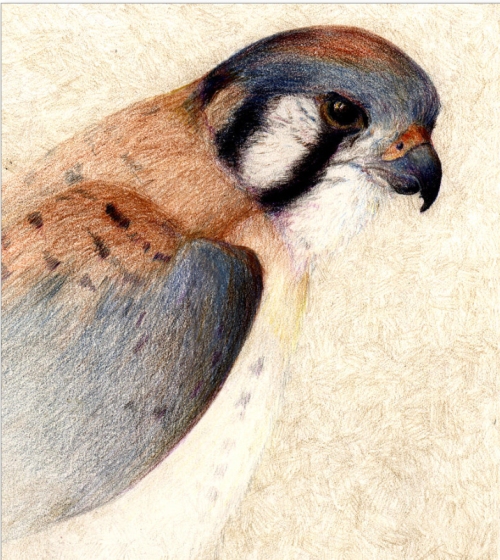
Did you ever take any art lessons?
Absolutely…and I still take art lessons whenever possible. I’m definitely addicted to learning. I took one art class as an undergraduate, but much of my illustration training is from the Science Illustration program and the amazing instructors that are still teaching there. I’ve pondered whether I should go back to school for a degree in Children’s Book illustration.
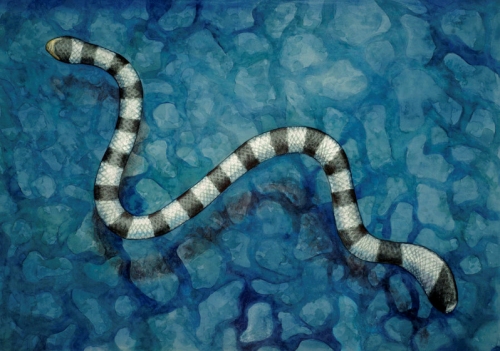
What was the first art related thing you got paid for?
This Kelp Forest illustration for a brochure on diving in the Monterey Bay National Marine Sanctuary. It was a work-for-hire project. Graphite, but printed in one-color (blue).
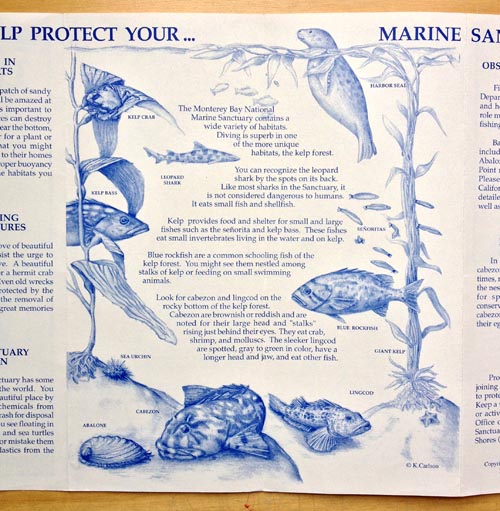
How did you get your first picture book assignment? Which book was it?
My first picture book assignment was a story called “You Can’t Untie a Knot of Toads.” It’s a concept book about what groups of animals are called. A friend wrote it and wanted me to illustrate it, so we could submit it to publishers (we didn’t know about keeping writing & illustrating submissions separate). We got rejection letters from Chronicle and Houghton Mifflin and I have since lost touch with the author.
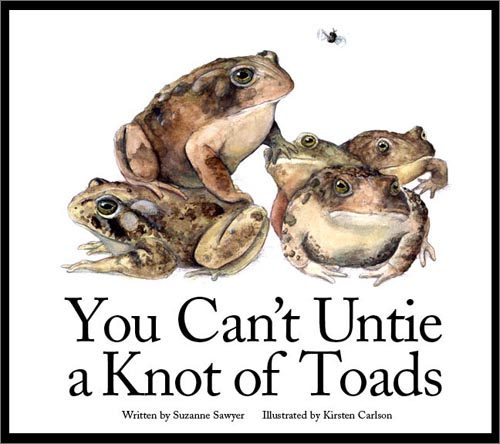
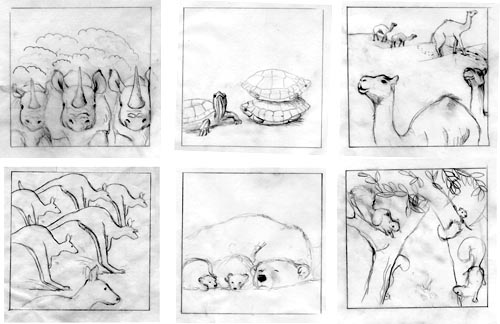
You have quite a resume with books, posters, greeting cards and magazines. Which one got you started?
I started with t-shirt designs and logo designs while still in high school. In my 20s, I did an internship with a group called Friends of the Sea Otter and they put my artwork on boxer shorts and sold tons of them. I think that officially nudged me in the direction of wanting to do more illustration.
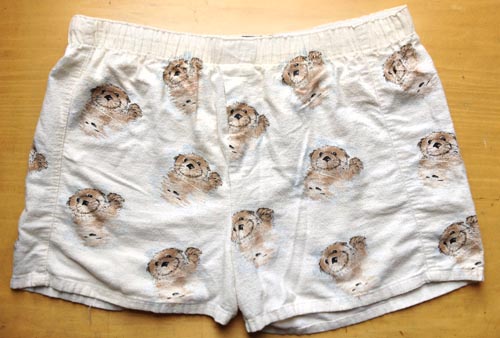
Do you think you will start submitting to the Children’s Magazines out there?
Yes. There are so many amazing magazines for kids and I think a few of them might find my illustration style appropriate. I submitted my work to Ranger Rick in the 90s but was rejected.
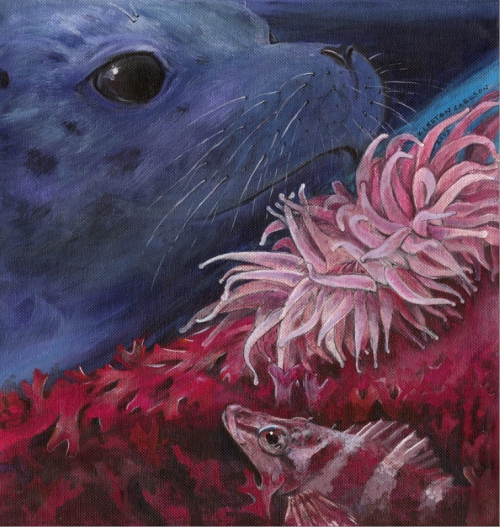
What types of things helped you develop your illustrations and style?
Going to graduate school for scientific illustration was a huge catalyst, and taking classes from people who inspire me through SCBWI and other informal educational groups. But, listening to feedback from fellow illustrators and sketching as often as possible have been the most valuable resources in developing my style. I’ve been consciously working on developing a more narrative style, like the character for Sleepy Seal.
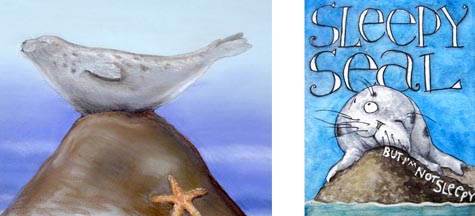
Have the materials you use changed over the years?
Most definitely. I’ve migrated from doing everything by hand to integrating the computer more and more. I still use pencil (and think it is integral to my style) as my primary drawing tool but I’ve expanded coloring my works digitally.
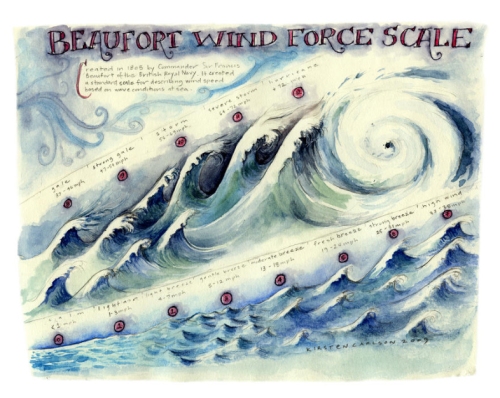
Have you ever tried to write and illustrate a children’s book?
Yes. I’ve actually been taking a break from illustrating to work on my own stories and strengthen my writing. I am currently working on three picture books and one middle grade illustrated novel. One of the picture books is called Pool Shark.
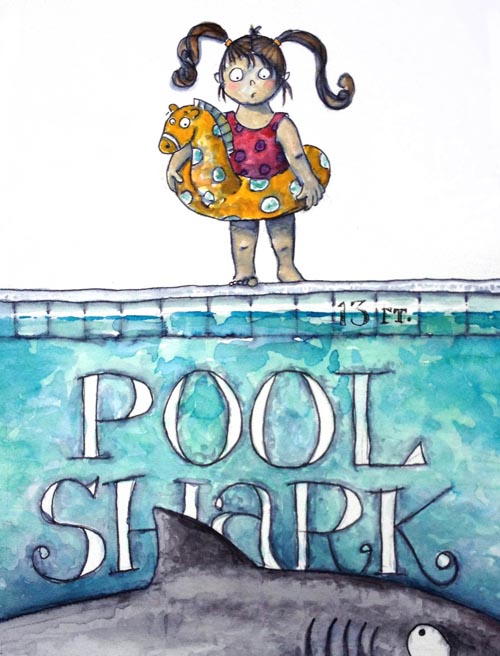
It looks like your first children’s book was “The Giraffe Who Was Afraid of Heights” by David Ufer and published by Sylvan Dell. How did you land that contract?
I was contacted by the publisher after attending the SCBWI NY conference in February 2005. The publisher saw my illustration of a polar bear and sent me the text for a story about a giraffe. I said, “Yes, please!” and I signed a contract two months later. I had six months to complete the artwork.
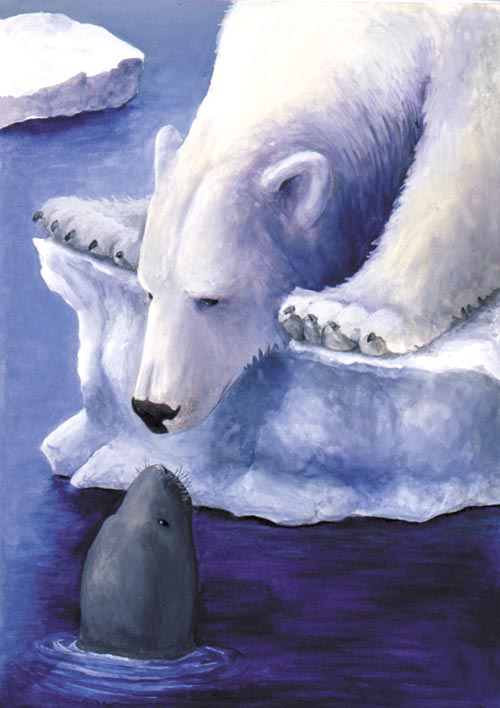
What types of things do you do to get your work seen by publishing professionals?
I have primarily attended SCBWI events and conferences—participating in portfolio and/or illustration showcases, and signing up for critiques. At the SCBWI LA conference, I won 1st place for Realistic Portfolio, two years in a row.

Do you have an agent? If so, who and how long have the represented you? If not, would you like one?
I do not have an agent and am definitely seeking someone to represent me.

How many books have you illustrated?
I’ve illustrated three picture books and one activity book.

Did you self-publish your new activity book, “Where the Land and Sea Meet”? How do people order it if they want a copy?
No, but I am the illustrator, author and art director. The activity book is an education outreach project that a team of scientists published through their universities. It is currently available in English from University of Alaska, Fairbanks, Alaska Sea Grant: http://seagrant.uaf.edu/bookstore/pubs/SG-ED-74.html
And is available in Italian from Pisa University Press:
http://www.edizioniplus.it/scheda-libro/carlson-kirsten/dove-terra-e-mare-si-incontrano-9788884927316-34091.html
It’s also been translated into Spanish but it’s not yet published.
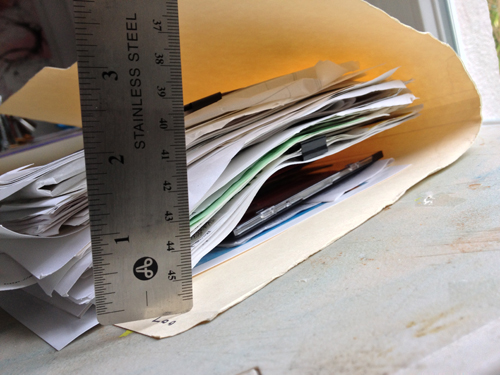
Talk about doing research and your homework. Kirsten takes it to the next level.
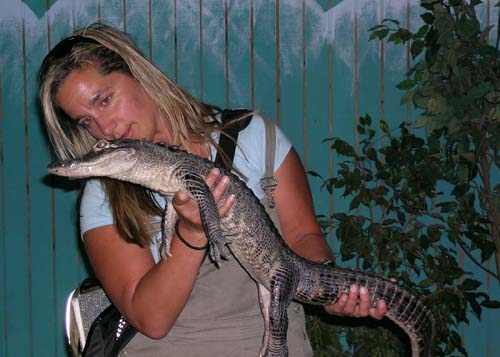
What types of research do you do for your illustrations? It looks like you snorkel. Do you take pictures or do any research before you start a project?
I love to do research, sketch and photograph extensively for projects. I enjoy learning as much as I love drawing. I will sketch in the cold & snow and even underwater to research my subjects.
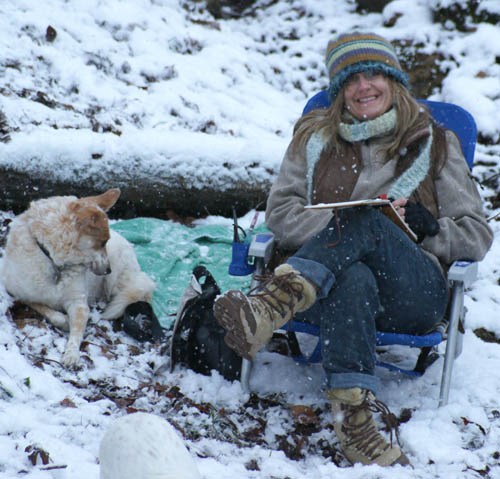
Who is Taylor Trade Publishing and how did you end up illustrating Sea Secrets: Tiny Clues to a Big Mystery for them?
They are the parent company for the imprint, Moonlight Publishing. They are printing and distributing all the educational picture books for a scientific group called The Long Term Ecological Research (LTER) Network. I was contacted by the Education and Outreach Coordinator for one of the LTER research groups because she like my illustrations for Ocean Seasons. I designed and illustrated the book for a flat fee, and worked with Beth Simmons, the Education and Outreach Coordinator on several more really fun education projects (but not kids books).
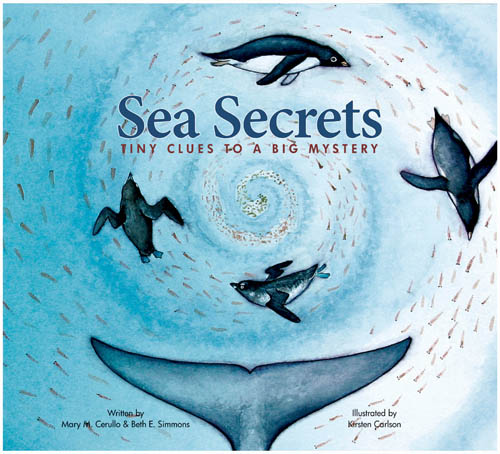
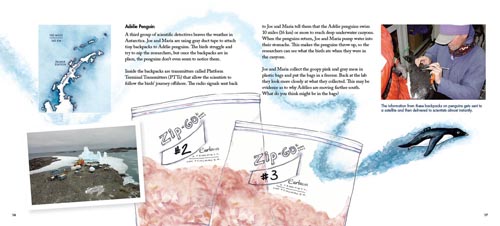
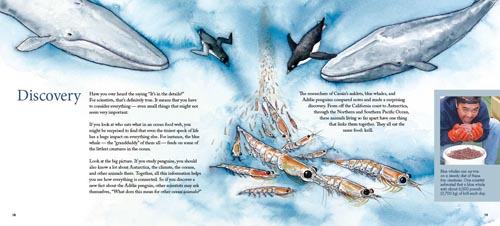
I see Ocean Seasons just came out in paperback. Was it previously printed as a hardcover?
It was published as a hardcover in 2007. Sylvan Dell also offers it as an eBook in Spanish & English.
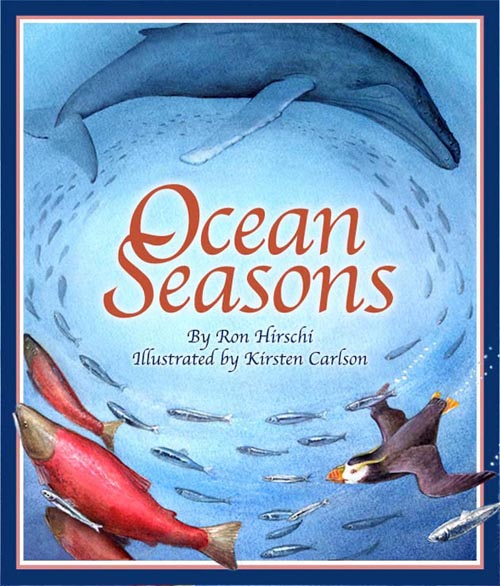
How do you keep your illustrating talent on the minds of your clients?
Ideally, I would be sending out postcards a few times a year, but I have a lot of opportunity to grow in this area. I’m becoming more active in social media as a way to stay connected to clients that are also using social media.
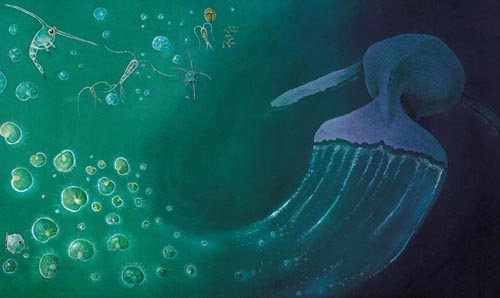
Have you gotten any work through networking?
Most definitely. Meeting people in person and showcasing my illustrations at conferences are the primary ways I’ve gotten work. Specifically, at conferences involving the Society of Children’s Book Writers & Illustrators, National Marine Educators Association, and Western Society of Naturalists.
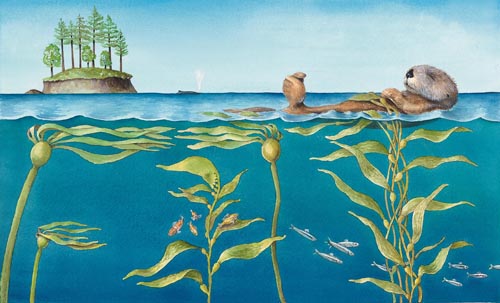
Do you do any art exhibits to help get noticed?
I’ve done one every few years, they are a great motivator to produce work and it’s a great way to reach out to the local community.

Do you ever use Photoshop?
Almost every day. I haven’t decided if I will continue to use them since they are going to be subscription-only, but for now I use Adobe CS5 for 99% of my digital work.
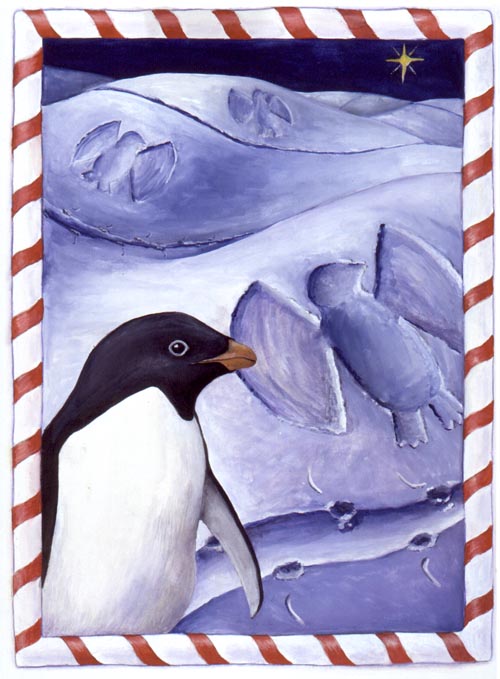
Do you own a graphic tablet? If so, how do you use it?
I have and adore my Wacom Cintiq display and Bamboo tablet. They are fantastic tools for working digitally. I use them primarly for touching up work.
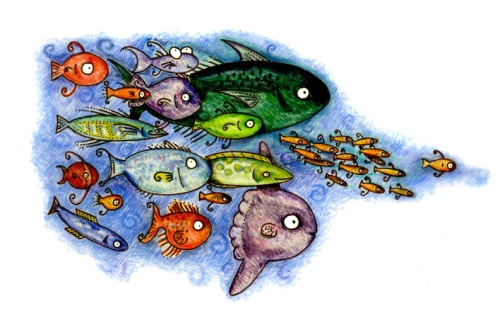
How much time do you spend working on your illustrating?
In an ideal week, I spend 20-30 hours on illustrating. However, I’ve invested a lot of time in the last two years to writing and networking. The last year has been less than ideal creatively because my husband was deployed to Afganistan, and I had to juggle several things solo. But now he’s back and things are getting back to normal. As soon as we’re settled in Hawai’i, I look forward to getting back to my ideal week.

Do you still do your greeting cards?
Yes! I did a greeting card as a promotional mailer for Valentine’s Day this year. The company that originally distributed my cards went out of business and the copyright has reverted to me, and I’d like to continue doing greeting cards as part of my income stream. They are fun and enjoyable short-term projects.
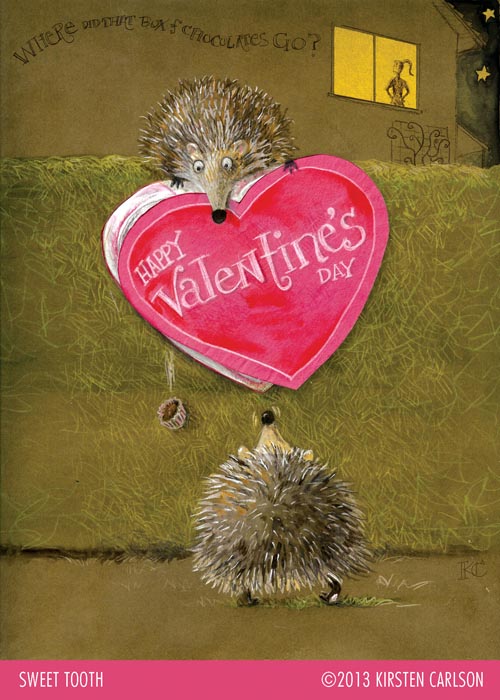
What is the most important tool or material that you use?
I love my sketchbook bag with my beat-up watercolor set, waterbrush, pen and sketchbook. All my art supplies and the computer are tied for a very close second place.
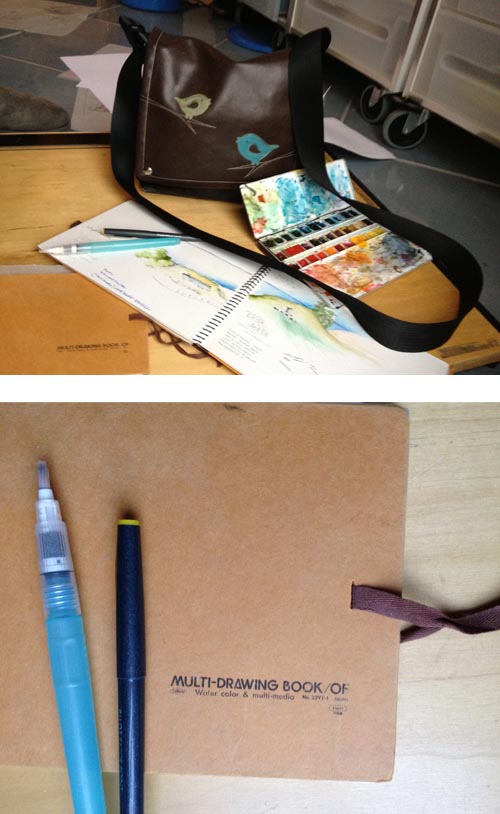
Any exciting projects on the horizon?
No contracts at the moment, but I’m working on several self-motivated projects.

What are your career goals?
My goals are to work on creative projects daily — to do a combination of authoring and/or illustrating children’s stories, creating illustrations for licensing and selling ocean wildlife art in a gallery setting. I have an income goal to make between $10,000 and $1,000,000 annually, dependent on production. I fell far short of that this year.
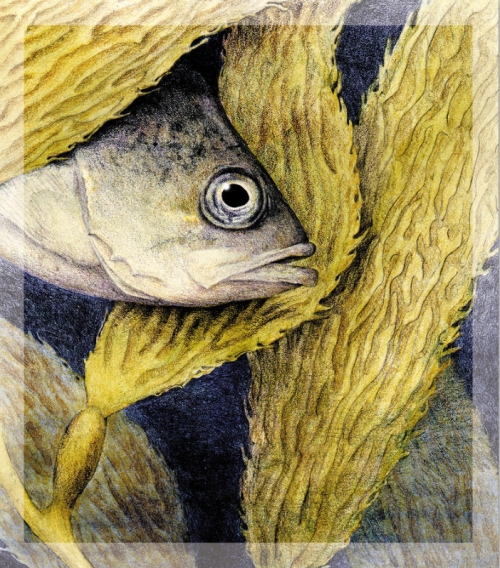
What are you working on now?
I’m focused mostly on the writing-illustrating projects I mentioned earlier.
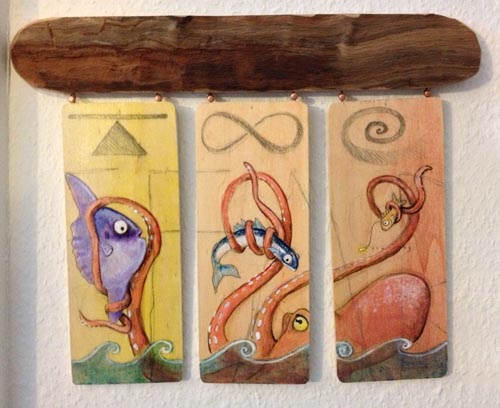
Are there any tips.(Example: Something you love – the best place to buy – a new product that you’ve tried – A how to tip, materials etc.) you can share that work well for you? Technique tips?
I’d recommend trying out a medium you’ve never used, because I did that and it affected me in an unexpected way. I recently took an abstract-art class, created something that was completely outside my style and it helped me loosen up so that I could create a more spontaneous whimsical piece of work (a triptych on wood) that is one of my favorites.
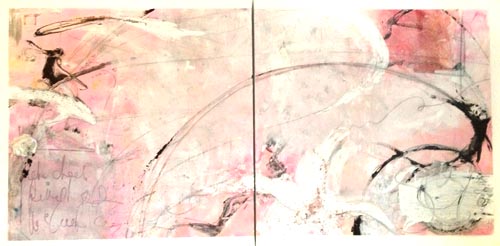
Any words of wisdom you can share with the illustrators who are trying to develop their career?
Stay committed. No matter what.
Keep creating and surround yourself with supportive friends and colleagues, reach out and mentor folks that can learn from you and ask for help from folks you would like to have as mentors.
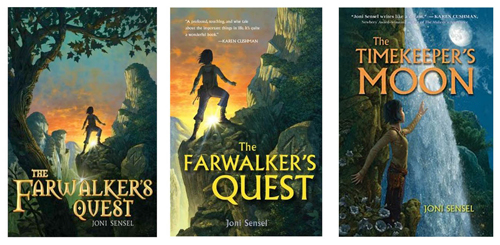
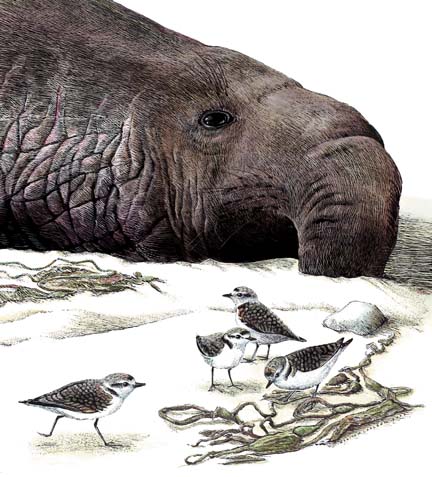 Thank you Kirsten for sharing your process and journey with us. Boy, you really do go the extra mile holding alligators, swimming to the bottom or the ocean, and weathering the cold and snow to get close to nature and your subjects. I enjoyed doing this post and wish you much additional success. For those of you who would like to visit Kirsten you can find her at: www.kirstencarlson.net and www.artsyfishy.com Her twitter name is: kirstencarlson
Thank you Kirsten for sharing your process and journey with us. Boy, you really do go the extra mile holding alligators, swimming to the bottom or the ocean, and weathering the cold and snow to get close to nature and your subjects. I enjoyed doing this post and wish you much additional success. For those of you who would like to visit Kirsten you can find her at: www.kirstencarlson.net and www.artsyfishy.com Her twitter name is: kirstencarlson
Hope you will take minute to leave Kirsten a comment. It is appreciated.
Talk tomorrow,
Kathy
Filed under: authors and illustrators, Illustrator's Saturday, inspiration, Interview, Process Tagged: Artist, Illustrator Saturday, Kirsten Carlson, Montery Bay Aquarium, scientist
Blog: Litland.com Reviews! (Login to Add to MyJacketFlap)
JacketFlap tags: Uncategorized, adventure, book, fiction, young adult, children's, character, genetics, high school, teen, scientist, Greek myth, Greek, sci fi, heroine, Add a tag
Workinger, Shelley. (2010). Solid. Published by CreateSpace. ISBN: 1-453-62482-1. Author recommended age Tweens & Teens: Litland.com recommends ages 14+ due to sexual references.
Publisher’s description: Eighteen years ago, a rogue Army doctor secretly experimented with a chromosomal drug on unknowing pregnant women. Almost two decades later, the newly self-proclaimed “open-book” military unearths the truth about the experiment, bringing Clio Kaid and the other affected teens to a state-of-the-art, isolated campus. While exploring her own special ability, forging new friendships and embarking on first love, Clio also stumbles onto information indicating that the military may not have been entirely forthcoming with them and that all may not be as it seems…
Our thoughts:
Showing rather than telling, the prologue opens to a high ranking military officer engaged in some secret work. Invisibility. Glowing. But these are just lab rats…
Fast forward to the present. Calliope Grace Kaid (Clio for short) starts at new schools frequently. While she may be an old hand at being the newbie, readers can still relate to how it feels. Worrying about making friends that move away, cliques excluding her, and just plain looking stupid, for the first time she is on a level playing field with her peers. They’ve all been invited to this high school summer camp, and at age 17 presumably have some maturity of social skills. Unlike Clio, whose military father died and her mother moved them around until becoming established in her own career, the other kids are military brats, military families that move from base to base as assigned. So for the first time, Clio is starting a camp where she at least has this in common with the other kids. Everyone’s a newbie here.
The author has given Clio just enough sarcasm and cynicism to be a very realistic American teenager, while maintaining an inner nature of goodness which exemplifies the character traits we seek in good kid’s literature. Through her self-talk, we relate to her insecurities and self-criticisms, how she responds to a cute guy’s behaviour, hoping not to make too many social mistakes.
It’s refreshing to have a female heroine who is solid in her own strengths, without a publisher seeking to make her a feminist vixen hoping to sell more books or make the story more attractive for a future movie. Through self-talk, we find this main character takes an inquisitive look at her world, particularly figuring out people, but in a manner that isn’t negatively judgmental of them. In doing so, she ponders how it is for adults to deal with issues like death, thus being able to almost empathize with them. An older teen should have achieved this level of maturity, thus rounding out her character well.
For example, Clio isn’t desperate for friends even if she is used to moving a lot and losing them. Or as she puts it, just seeing them on Facebook. So she isn’t trying to endear herself to as many peers as possible in an attempt at securing popularity. Rather, she is using good discernment on who she intends to hang with, such as with Miranda: “Abrasive was one thing, but if she turned out to be slutty too, our friendship would be short-lived.”
And how refreshing it is that the girls who might be
Blog: OUPblog (Login to Add to MyJacketFlap)
JacketFlap tags: college, Science, A-Featured, Medical Mondays, Scientist, funding, Grant, graduate, Schwartzkroin, Add a tag
Philip A. Schwartzkroin has been a research scientist for over 35 years. Through his many years in the laboratory, he has trained and mentored numerous postdoctoral fellows and graduate and undergraduate students many of whom have gone on to establish successful leadership roles in their chosen areas of research. Dr. Schwartzkroin currently is Professor of Neurological Surgery at the University of California-Davis, an affiliate of the UC Davis Center for Neuroscience, and holds the Bronte Endowed Chair in Epilepsy Research in the UC Davis School of Medicine. His book, So You want To Be A Scientist?, provides a glimpse into the job of being a research scientist, addressing explicitly many issues that are rarely addressed directly in training programs. In the original post below we learn how to react to the rejection of a research grant application.
Are you interested in a career as a research scientist? Do you have any idea what is involved in such a career? Graduate training programs do a good job in preparing students with facts and in teaching technical laboratory skills. But there is a lot more to the job of being a researcher than simply doing experiments. And many of the needed skills are not explicitly taught.
For example: How do you get grants to support your research?
Let’s say you’ve submitted a grant application and the reviewers don’t like it – and so recommend that the granting agency not provide funding. You try again, addressing the concerns and critiques of the reviewers – but the review scores for this second application are only marginally better than in the first round. What do you do then? This conundrum is not uncommon, and the appropriate response requires perseverance, confidence, and guidance. Here are some suggestions (certainly not exhaustive) about how one might proceed:
you do then? This conundrum is not uncommon, and the appropriate response requires perseverance, confidence, and guidance. Here are some suggestions (certainly not exhaustive) about how one might proceed:
1) Do additional experiments that provide more compelling preliminary data.
2) Ask a senior mentor to help you “read between the lines.” While you may have, in your revised application, addressed the explicit criticisms expressed in the first review, you may have missed an important implicit message. For example, reviewers often try to let you know that they simply don’t find your questions or topic very interesting - without actually saying that. It would be important to know if that were the case.
3) Get input – hopefully honest and objective - from your colleagues who do not work directly in the area of the grant application. One of the difficult tricks in getting grant support is convincing the reviewers - who are likely not to be working in your area of interest - that your ideas are important and that your experimental approach will yield significant new insights. Sometimes it’s hard for a researcher to gain sufficient distance from his/her own work to get a good sense of whether the grant application succeeds on this level.
4) Request that your application be reviewed (in the next round) by a different review panel. This alternative might be effective if you suspect there is a member of the initial review group who is “sabotaging” your application, or if you think that the group simply doesn’t have the expertise/interests to review your application appropriately.
5) Try sending the application to another granting agency that has a more direct interest in your area of study. For example, a private foundation with a particular area of concern may be more sympathetic to work on “their” topic than a large government agency that deals with applications that cover a broad range of topics.
6) Alter the focus of your proposal if you think that will provide a more effective “hook.” Such an alteration does not necessarily mean changing your proposed experiments. Rather, it may involve a change in emphasis, using different key words, reorienting the background and rationale sections of the application.
7) Forget about the experiments proposed in your application, and develop another set of studies that you think are more likely to be funded. It is important to learn when to “cut bait” and go on to something more productive. This decision is very difficult. Indeed, we scientists usually resist pressures to change our research directions. But this alternative is always important to consider.
Blog: Justine Larbalestier (Login to Add to MyJacketFlap)
JacketFlap tags: Writing & Publishing, Vainglory, GreatOzElvisM'steenCricketFairyNvl/TheUltimateFairyBook, Add a tag
Thanks so much for all the warm yummy wishes. I’m bubbly and bouncing!
I’ve been getting some questions about my next book. I figured it would be most efficient to answer them all here:
Q: Will it be in hardcover or paperback?
A: Hardcover first and then later (don’t know how much later) paperback.
Q: Penni asked: Are you signing a contract for a book you haven’t written yet?
A: It’s like this: Bloomsbury have bought two books from me, the already-written UFB + an unwritten second book. Yes, that means I’ll be writing one novel of the contract to deadline. I know I said I wouldn’t do that anymore. But the writing-a-book-at-my-own-pace thing (which resulted in the UFB) was an experiment. I think I’m ready to tackle novel to deadline once again. Especially as I’ll have oodles of time and have already started a new novel. Plus Bloomsbury wanting a second book shows that they as a company are committed to me as a writer, which makes me feel warm and bubbly.
Q: Dess asked: Is there a difference between fairies and faeries?
A: There is. While as Diana pointed out they all have the same etymological root, in modern fantasy using “faerie” usually means the story will be influenced by Celtic or English mythology. There are lots of ballads that deal with the faerie folk. Those are a big influence on Holly Black’s work for instance. Her faerie are darker and scarier than mine. Also mine are invisible and not influenced by the Celtic or English traditions at all.
Q: Are there mangosteens and cricket matches and Elvis and monkey-knife fights in it?
A: Yes.
Q: Is it set in Australia?
A: Um. Sort of.
Q: Why did you leave your old publisher?
A: I had a three-book deal with Penguin/Razorbill for the Magic or Madness trilogy. So my contract with them was done. My new book is so completely different from the trilogy that it seemed a good time to find the best possible match for it. My agent and I both agree Bloomsbury are a wonderful home for the UFB.
Q: Maggie asked: Are ultimate fairies anything like extreme fairies?
A: Could be.
Blog: Justine Larbalestier (Login to Add to MyJacketFlap)
JacketFlap tags: Writing & Publishing, Praising, Vainglory, Great Aussie Elvis Mangosteen Cricket Fairy YA Novel, young adult literature, New York City/USA, Great Aussie Elvis Mangosteen Cricket Fairy YA Novel/Th, GreatOzElvisM'steenCricketFairyNvl/TheUltimateFairyBook, Add a tag
My big news is that my next two books are going to be published by Bloomsbury USA. That’s right the great Aussie cricket mangosteen monkey knife fighting fairy YA novel has found a home! Not to mention an actual title: The Ultimate Fairy Book.
I am so excited I cannot sit still. I’m bouncing as I type this. I am all over with yays!
My new editor is Melanie Cecka who is wonderful. We had a three-hour lunch last year where we learned conclusively that we are each girls after each other’s heart. Hot sauce! Mexican food! Dessert! Love of many of the same books!
The whole team at Bloomsbury are incredibly impressive and seem to be almost as excited about my book as I am about becoming a Bloomsbury girl. It’s a match made in heaven. Just take a look at some of the books they publish! I am going to be on the same list as Shannon Hale, Simmone Howell, Susan Vaught, Herbie Brennan, Phillip Reeve! What’s not to love?
Before you ask The Ultimate Fairy Book or the UFB is scheduled to be published in Fall 2008 (ie September or October of next year). I know some of you will think that is a long, long, long, way away, but I was very surprised that they’re going to publish it so soon. Most publishers have already planned their Fall 08 list and are now plannning their 2009 books. I squealed when I heard it was coming out next year. More yays!
Also being on the Fall list in the US of A (and let’s face it where else do they even have a fall*?) is a Very Big Deal. The majority of the books featured at BEA, for instance, are Fall titles.
*Where I come from it’s autumn.






Kirsten’s work is absolutely beautiful. A deep dedication to everything she does is apparent. Great interview!
What a wonderful interview, Kirsten! Your art is amazing!
Hi Kristen,
I so enjoyed learning about your sratchboard method.
I loved the otter floating on his back. All of your illustrations are beautiful, and I enjoyed reading about your underwater adventures.
Wonderful interview and fabulous illustrations. I especially love all her frogs and the polar bear and seal. Just beautiful. Thanks for doing this every week. I so look forward to it.
Beautiful work!
How amazing to see the variety of work here, Kirsten! It’s great to still be able to keep up with all your activity. I loved, loved seeing the artwork and photos and hearing about your adventures. I’m resisting running to an art store right now, but thank you for the inspiration and for finding such an amazing niche in Science Art. Fun to see Joni’s book here, too. ; )
Wonderful post! Thanks so much for sharing in such great detail! e
e
Lovely work, thanks so much for sharing!
This is a wonderful post. I am so in awe of your work, Kirsten, and you are an inspiration for me. I love the ocean and have painted and illustrated ocean-themed work, but nowhere near your level of detail and realism.
I’m speechless!
Well, not quite. Kirsten your work is AMAZING! Beautiful, compelling, engaging…any picture book writer who has you illustrate their book is fortunate indeed.
Kirsten your work is AMAZING! Beautiful, compelling, engaging…any picture book writer who has you illustrate their book is fortunate indeed. 

I just came back from the 2013AFCC in Singapore which was a SCBWI conference plus…and I connected with German illlustrator Julia Kaergel who has done the Lotte books by Doris Dorrie. It was lovely getting an international perspective on writing and illustrating children’s books.
Best of luck in all you do…I know you will be wildly successful in Hawaii…or anywhere.